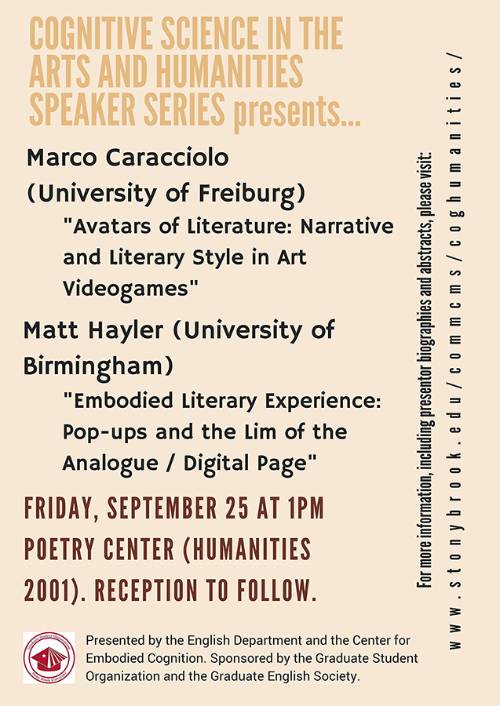Matt Hayler and Marco Caracciolo
25 September 2015
Embodied Literary Experience: Pop-ups and the Limn of the Analogue / Digital Page
The importance of embodiment to the practice of reading has come under increasing scrutiny as psychologists, theorists, and other concerned parties have noted the increasing differences in reading practices across printed page and digital screen. E-reading, for all of its convenience, has often been positioned as a threat to our psychology, cognition, or to the beneficial practice of reading more broadly. I have written about the nature of these fears extensively elsewhere (Challenging the Phenomena of Technology, 2015); in this paper I will instead further build out the understanding of embodied reading practices with a focus on postphenomenology and the entanglement of reader and device.
The role of embodiment in reading requires more than looking to the reader’s hands and to the gestures that they make, though these play their part in meaning. I will look at the physicality of both print and digital works and consider how the reader and the book, as two embodied entities, come together during reading to impact upon the text produced in some subtle and explicit ways. By seeing reading as a process that occurs at the nexus of two entangled bodies we can better understand the embodied metaphors, or grammars, that become bound up in interpretation – paper, covers, and bindings have meanings that shape every text attached to a codex, and now screens are building up the same metaphorical weight that might be deployed. This paper will look at experiences of both print and digital texts, but also of a recent pop-up art book that works across the mediums, drawing on both and their interplay in order to be at its most meaningful.
Watch Video
Stream/Download Audio:
https://archive.org/details/MattHaylerSBU-9-25-15
View Dr Matt Hayler's work: Challenging the Phenomena of Technology: Embodiment, Expertise, and Evolved Knowledge
“This Island Is a State of Mind:” Experimental Narrative and the Spatialization of Mental Processes
Ideas enter our mind, a realization can dawn on us, and we should let bad news sink in. Metaphorical language is everywhere—even when it comes to thinking and talking about mental processes. These metaphors, as cognitive scientists have often pointed out, work by mapping perceptual experience onto seemingly immaterial psychological events (Mark Johnson, "Metaphor and Cognitive Science"). Particularly common mappings are “ideas as physical objects” and “mind as physical space” (see John A. Barnden, "Consciousness and Common-Sense Metaphors of Mind").
This paper argues that experimental narrative can build on this tendency to spatialize our psychological life. My case studies will be a short story by J. G. Ballard, “The Terminal Beach” (1964), and Dear Esther (2012), an art videogame developed by The Chinese Room. The audience of both narratives is confronted with the physical space of an island and cued to interpret it metaphorically: imagining this place—and, in the case of the videogame, interacting with it—become a way of grasping the protagonist’s existential predicament. This set-up is unsettling, I contend, because it questions presumptions about the separation of mind and world: it thus serves as a source of both epistemological instability and narrative interest. This argument should be read as an attempt at cross-fertilizing embodied approaches to narrative with discussions on the enmeshment of human and material realities in fields such as posthumanism (Cary Wolfe, What is Posthumanism?) and ecological philosophy (Jane Bennett, Vibrant Matter; Timothy Morton, The Ecological Thought).
Watch Video:
Stream/Download Audio:
https://archive.org/details/MarcoCaraccioloSBU-9-25-15
View Dr Marco Caracciolo's work: The Experientiality of Narrative: An Enactivist Approach academia.edu

